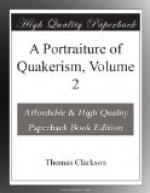I shall conclude this chapter on the subject of the Quaker preaching, by an extract from Francis Lambert of Avignon, whose book was published in the year 1516, long before the society of the Quakers took its rise in the world. “Beware, says he, that thou determine not precisely to speak what before thou hast meditated, whatsoever it be; for though it be lawful to determine the text which thou art to expound, yet not at all the interpretation; lest, if thou doest so, thou takest from the Holy Spirit that which is his, namely, to direct thy speech that thou mayest preach in the name of the Lord, void of all learning, meditation, and experience; and as if thou hadst studied nothing at all, committing thy heart, thy tongue, and thyself, wholly unto his spirit; and trusting nothing to thy former studying or meditation, but saying to thyself in great confidence of the divine promise, the Lord will give a word with much power unto those that preach the Gospel.”
SECT. II.
But besides oral or vocal, there is silent worship among the Quakers—Many meetings where not a word is said, and yet worship is considered to have begun, and to be proceeding—Worship not necessarily connected with words—This the opinion of other pious men besides Quakers—Of Howe—Hales—Gell—Smaldridge, bishop of Bristol—Monro —Advantages which the Quakers attach to their silent worship.
I have hitherto confined myself to those meetings of the Quakers, where the minister is said to have received impressions from the Spirit of God, with a desire of expressing them, and where, if he expresses them, he ought to deliver them to the congregation as the pictures of his will; and this, as accurately as the mirror represents the object that is set before it. There are times, however, as I mentioned in the last section, when either no impressions may be said to be felt, or, if any are felt, there is no concomitant impulse to utter them. In this case no person attempts to speak: for to speak or to pray, where the heart feels no impulse to do it, would be, in the opinion of the Quakers, to mock God, and not to worship him in spirit and in truth. They sit therefore in silence, and worship in silence; and they not only remain silent the whole time of their meetings, but many meetings take place, and these sometimes in succession, when not a word is uttered.
Michael de Molinos, who was chief of the sect of the Quietists, and whose “Spiritual Guide” was printed at Venice in 1685, speaks thus: “There are three kinds of silence; the first is of words, the second of desires, and the third of thoughts. The first is perfect; the second is more perfect; and the third is most perfect. In the first, that is, of words, virtue is acquired. In the second, namely, of desires, quietness is attained. In the third, of thoughts, internal recollection is gained. By not speaking, not desiring, and not thinking, one arrives at the true and perfect mystical silence, where God speaks with the soul, communicates himself to it, and in the abyss of its own depth, teaches it the most perfect and exalted wisdom.”




